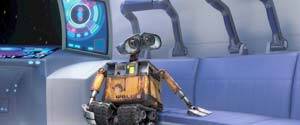Twice during my matinee visit to the multiplex to see Wall-E, two different toddlers started crying inconsolably and had to be taken from the theater. The Disney name and the G rating might have misled their mothers into thinking they were taking their children to a cheery cartoon with pastel flowers, singing bunnies and dancing butterflies. Not so. The unrelieved grimness of the ruined urban landscape in the opening scenes seems to have gotten to the first child. It was too sad and ugly for the tot to process. The second could not endure the brutal pummeling that almost destroys the main character, who by that point in the film had endeared himself to his young audience. Older kids, long hardened to the ways of electronically simulated violence, could probably deal with this material handily and enjoy the story with some enthusiasm. Put me with the older kids. I loved it, but perhaps for very different reasons.
“Wall-E” opens on a blasted urban landscape. What appears to be a jungle of ruined skyscrapers gradually comes into focus through the smog. Tall buildings with empty windows and buckling steel beams mingle with giant mounds of compacted scrap. The city has evolved into a dump, with no distinction between monumental buildings of some past civilization and mountains of refuse. They are one. Recall the post-apocalyptic griminess of “Blade Runner” (1982) or “Mad Max” (1979) to gain some sense of the visuals. (There goes the first of my little theater mates.) The script, written by the director Andrew Stanton with Jim Reardon, takes its time in filling in the back story. We are curious. How did all this come to pass?
The only motion in this rusting universe comes from the eponymous hero, Wall-E (Waste Allocation Load Lifter Earth-Class), a dented, rust-stained robot, with a head made of two cameras that looks and tilts much like the oversized dome Steven Spielberg put on E.T. (1982). Actually, he looks pretty good for a machine that’s been working for 700 years. His solar-powered batteries recharge every morning, like the first jolt of caffeine for the rest of us, and he goes about his preprogrammed tasks without ever wondering about the point of his labors. He wanders through the ruins on his tractor treads, collects scrap, compacts it in his belly and deposits the brick-shaped bundles ever higher in perfectly squared mounds until they rival the ghostlike office buildings. In 700 years, he’s been able to compact and stack a lot of stuff.
As we soon discover, Wall-E discriminates in the trash he collects; he harbors nostalgia for the old days. His townhouse sports a junkyard motif, since he is continually on the lookout for interesting fellow gadgets. Among his most beloved possessions is a Zippo lighter of 1940s vintage. Known for its durability during wartime, it still works despite the cataclysms it has faced. It is a marvel of technology, a survivor, much like Woody Allen’s 200-year-old Volkswagen in “Sleeper” (1973) and like Wall-E himself. No mere automaton, he is a bit of a sentimentalist. He has decorated his lair with Christmas tree lights, and for entertainment in his leisure hours, he plays an old videotape of “Hello, Dolly!” (1969).
I doubt that many of my youthful pals in the theater caught any of this, but the historian in me was delighted by the consistently smart and pointed allusions to earlier movies. The technique also demonstrates a major theme of the film: earlier inhabitants of this city created a disposable culture. As a result, they buried themselves in garbage to such a degree that the planet could no longer sustain life. With his junkyard bedroom, Wall-E treasures artifacts from the past and recycles them for present use. When one of his parts wears out, he simply rummages around to find a replacement. Taking their cue from the robot, the filmmakers have recycled movie history and made a point on conservation of our artifacts without being preachy about it.
One day Wall-E’s routine is forever broken when a spaceship deposits a shiny white robot shaped something like a computer mouse. While Wall-E clings to the earth on steel tank treads, the visitor is not subject to gravity. It zips around the debris on what appears to be an inspection tour. Wall-E follows it, and when the two finally meet, the visitor sputters and squeaks like R2-D2 in the first “Star Wars” (1977). Its onboard computers identify a mutually intelligible language, and the newcomer identifies herself as Eve (Extraterrestrial Vegetation Evaluator). Even the beginners in Sunday school would recognize the mother of human life, but the script uses its symbols so deftly that few of them would have been distracted by the theology. We now have first parents falling in love in a ruined Eden. Because of their love, they offer this dead planet a second chance.
In the tradition of the screwball comedies of the 1930s and 1940s, the lovers come from opposite sides of the track—or of the universe. She’s slick and modern; he’s a product of clunky 22nd-century technology. Her creators want her back in their own galaxy, simply to see if she has been successful in detecting vegetation—that is, life—on the barren planet. Love will not be denied, however. Wall-E will follow her to the ends of the galaxy, literally.
The kidnappers from outer space bring their cargo back to a mother ship, which looks like a cruise liner designed by the special-effects team from “Close Encounters of the Third Kind” (1977). The human captain is a mere figurehead. Computers actually run the operation under the command of a particularly nasty bit of electronics called AUTO that out-HALs HAL from “2001: A Space Odyssey” (1968). Buy N Large, a multinational corporation that once urged its customers to buy more and bigger and dump the leftovers wherever, launched this artificial planet as a refuge for its favored customers after the earth choked on its own litter. Now these descendants of earthlings have carried their consumer culture to its obvious conclusion. Bulbous bodies, looking like Teletubbies stuffed into spandex, float on recliners patterned after those first-class airline seats that no one I know could ever afford. They give obesity a bad name. Their bloated faces hide behind screens that provide endless entertainment, and they need only stick out their hand to have a robot deliver yet another megacalorie treat. This world will end not with a bang or a whimper, but with a burp. Keeping with its corporate philosophy, B N L dumps tons of waste into space. The entire universe is theirs to pollute. The plus-sized passengers can’t bother about such things. “Get me another giant shake.”
Here on the spaceship, the threads of the narrative come together: romantic comedy, space adventure, ecological parable. The fate of the universe rests with Wall-E. AUTO’s sinister henchmen capture Eve to keep her from revealing her secret to the humans. Wall-E’s attempted rescue pits him against an army of rogue robots who want to tear him apart, rivet by rivet, and nearly succeed. (There goes my second little friend.) The reclining humans hang in the balance. Will they accept the challenge of returning to the planet of their ancestors and building a new society, or do they actually prefer a life of massive Slurpees and mind-corroding television? Will true love triumph in the time-honored Hollywood tradition? If only Indiana Jones or Arnold the governor were here to help them escape!
After nine previous collaborations, the Disney-Pixar partnership has once again pushed the envelope. Of course, one has to admire the technology that has brought animation to such an incredible level of expressiveness. Imagine giving two robots enough personality to make us really care about them. Their romantic relationship has its light moments, like the friendship of R2-D2 and C-3PO, but it also has a serious, human dimension that the “Star Wars” buddies lacked. Even more impressive is the fact that this bit of clever animation, with all its entertainment value, actually poses several serious questions about life on this blue planet without showing a bit of didacticism. The issues it raises last longer than the recollection of the stunning images. I only hope those two teary-eyed viewers come back in a few years and give this film another try. I’m sure they’ll find it as rewarding as I did.








